battery MAZDA 6 2002 Suplement Owner's Manual
[x] Cancel search | Manufacturer: MAZDA, Model Year: 2002, Model line: 6, Model: MAZDA 6 2002Pages: 909, PDF Size: 17.16 MB
Page 109 of 909
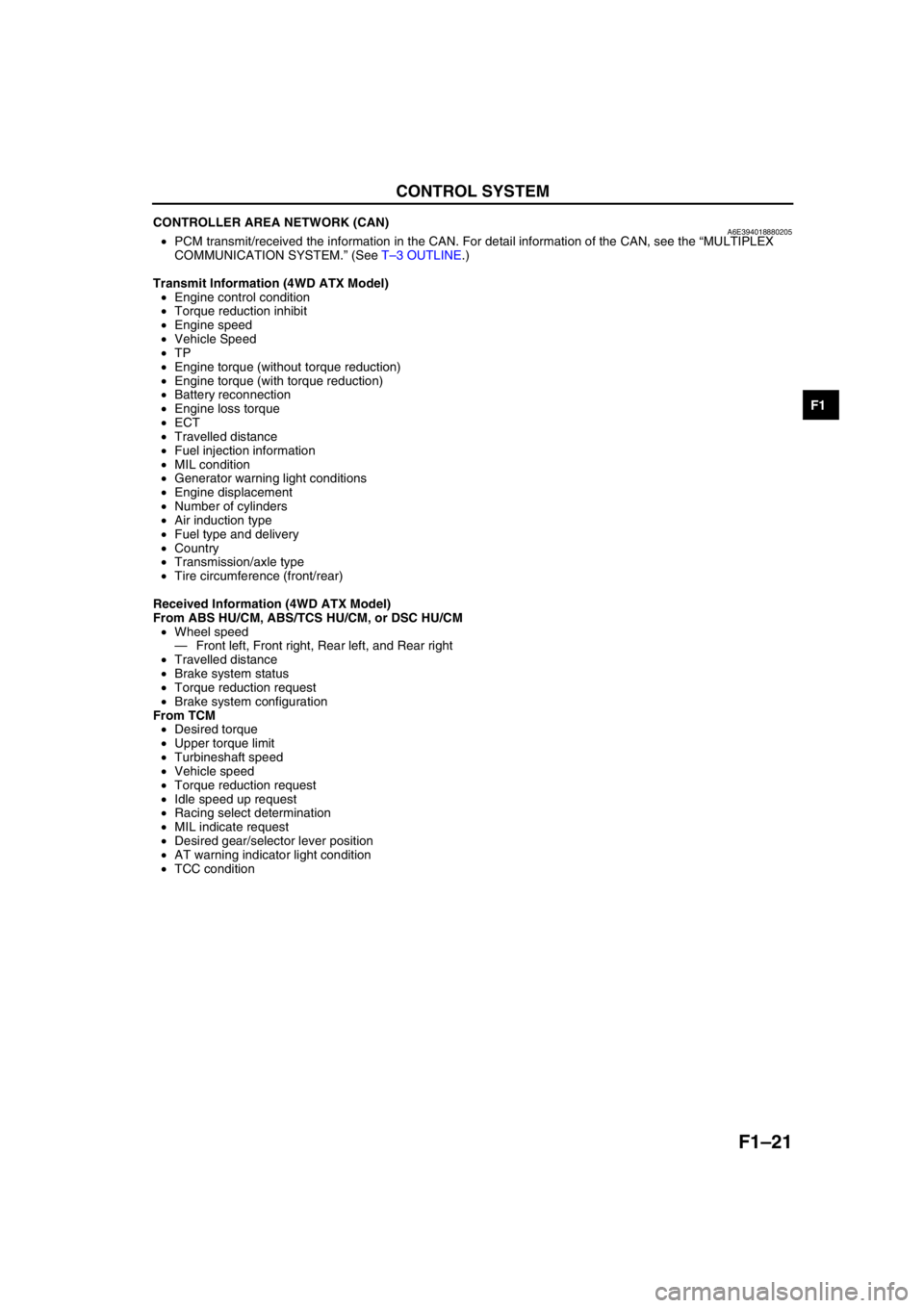
CONTROL SYSTEM
F1–21
F1
CONTROLLER AREA NETWORK (CAN)A6E394018880205•PCM transmit/received the information in the CAN. For detail information of the CAN, see the “MULTIPLEX
COMMUNICATION SYSTEM.” (See T–3 OUTLINE.)
Transmit Information (4WD ATX Model)
•Engine control condition
•Torque reduction inhibit
•Engine speed
•Vehicle Speed
•TP
•Engine torque (without torque reduction)
•Engine torque (with torque reduction)
•Battery reconnection
•Engine loss torque
•ECT
•Travelled distance
•Fuel injection information
•MIL condition
•Generator warning light conditions
•Engine displacement
•Number of cylinders
•Air induction type
•Fuel type and delivery
•Country
•Transmission/axle type
•Tire circumference (front/rear)
Received Information (4WD ATX Model)
From ABS HU/CM, ABS/TCS HU/CM, or DSC HU/CM
•Wheel speed
—Front left, Front right, Rear left, and Rear right
•Travelled distance
•Brake system status
•Torque reduction request
•Brake system configuration
From TCM
•Desired torque
•Upper torque limit
•Turbineshaft speed
•Vehicle speed
•Torque reduction request
•Idle speed up request
•Racing select determination
•MIL indicate request
•Desired gear/selector lever position
•AT warning indicator light condition
•TCC condition
End Of Sie
Page 111 of 909

FUEL SYSTEM
F1–23
F1
FUEL TANK REMOVAL/INSTALLATIONA6E391242110201
Warning
•Repairing a fuel tank that has not been properly steam cleaned can be dangerous. Explosion or
fire may cause death or serious injury. Always properly steam clean a fuel tank before repairing it.
•Fuel line spills and leakage are dangerous. Fuel can ignite and cause serious injuries or death and
damage. Fuel can also irritate skin and eyes. To prevent this, do not damage the sealing surface of
the fuel pump unit when removing or installing.
Caution
•Disconnecting/connecting the quick release connector without cleaning it may possibly cause
damage to the fuel pipe and quick release connector. Always clean the quick release connector
joint area before disconnecting/connecting using a cloth or soft brush, and make sure that it is
free of foreign material.
1. Level the vehicle.
2. Complete the “BEFORE REPAIR PROCEDURE”.
3. Disconnect the negative battery cable.
4. Remove the fuel pump unit. (See F1–26 FUEL PUMP UNIT REMOVAL/INSTALLATION.)
5. Remove the fuel gauge sender sub-unit. (See T–27 Fuel Gauge Sender Sub-Unit.)
6. Siphon the fuel from the service hole.
7. Remove the presilencer. (See F1–30 EXHAUST SYSTEM REMOVAL/INSTALLATION.)
8. Remove the TWC. (See F1–30 EXHAUST SYSTEM REMOVAL/INSTALLATION.)
9. Remove the propeller shaft. (See L–5 PROPELLER SHAFT REMOVAL/INSTALLATION.)
FUEL SYSTEM
Page 114 of 909
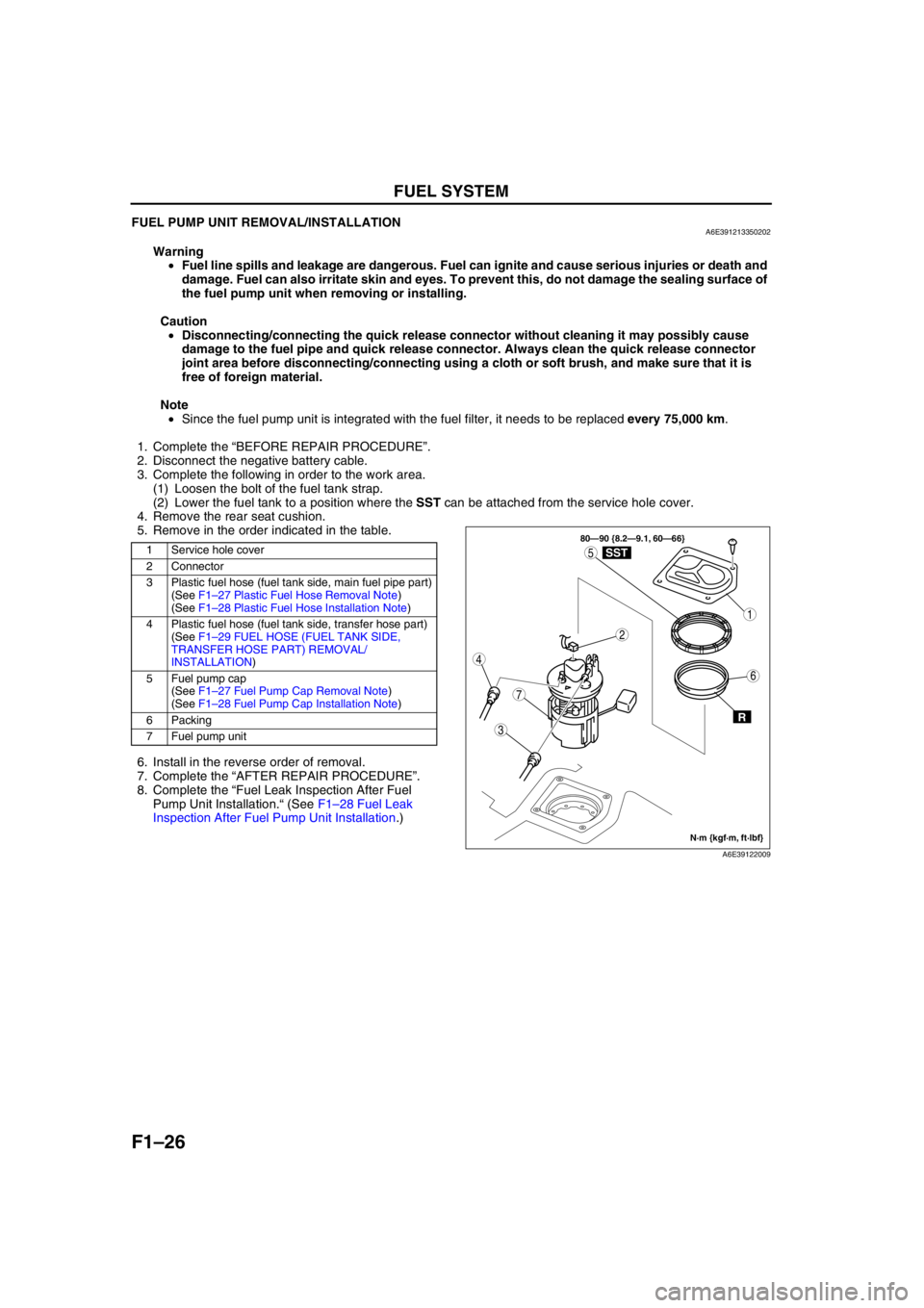
F1–26
FUEL SYSTEM
FUEL PUMP UNIT REMOVAL/INSTALLATIONA6E391213350202
Warning
•Fuel line spills and leakage are dangerous. Fuel can ignite and cause serious injuries or death and
damage. Fuel can also irritate skin and eyes. To prevent this, do not damage the sealing surface of
the fuel pump unit when removing or installing.
Caution
•Disconnecting/connecting the quick release connector without cleaning it may possibly cause
damage to the fuel pipe and quick release connector. Always clean the quick release connector
joint area before disconnecting/connecting using a cloth or soft brush, and make sure that it is
free of foreign material.
Note
•Since the fuel pump unit is integrated with the fuel filter, it needs to be replaced every 75,000 km.
1. Complete the “BEFORE REPAIR PROCEDURE”.
2. Disconnect the negative battery cable.
3. Complete the following in order to the work area.
(1) Loosen the bolt of the fuel tank strap.
(2) Lower the fuel tank to a position where the SST can be attached from the service hole cover.
4. Remove the rear seat cushion.
5. Remove in the order indicated in the table.
.
6. Install in the reverse order of removal.
7. Complete the “AFTER REPAIR PROCEDURE”.
8. Complete the “Fuel Leak Inspection After Fuel
Pump Unit Installation.“ (See F1–28 Fuel Leak
Inspection After Fuel Pump Unit Installation.)
1 Service hole cover
2 Connector
3 Plastic fuel hose (fuel tank side, main fuel pipe part)
(See F1–27 Plastic Fuel Hose Removal Note)
(See F1–28 Plastic Fuel Hose Installation Note)
4 Plastic fuel hose (fuel tank side, transfer hose part)
(See F1–29 FUEL HOSE (FUEL TANK SIDE,
TRANSFER HOSE PART) REMOVAL/
INSTALLATION)
5Fuel pump cap
(See F1–27 Fuel Pump Cap Removal Note)
(See F1–28 Fuel Pump Cap Installation Note)
6 Packing
7 Fuel pump unit
3
7
1
4
5
2
6
80—90 {8.2—9.1, 60—66}
R
SST
N·m {kgf·m, ft·lbf}
A6E39122009
Page 117 of 909
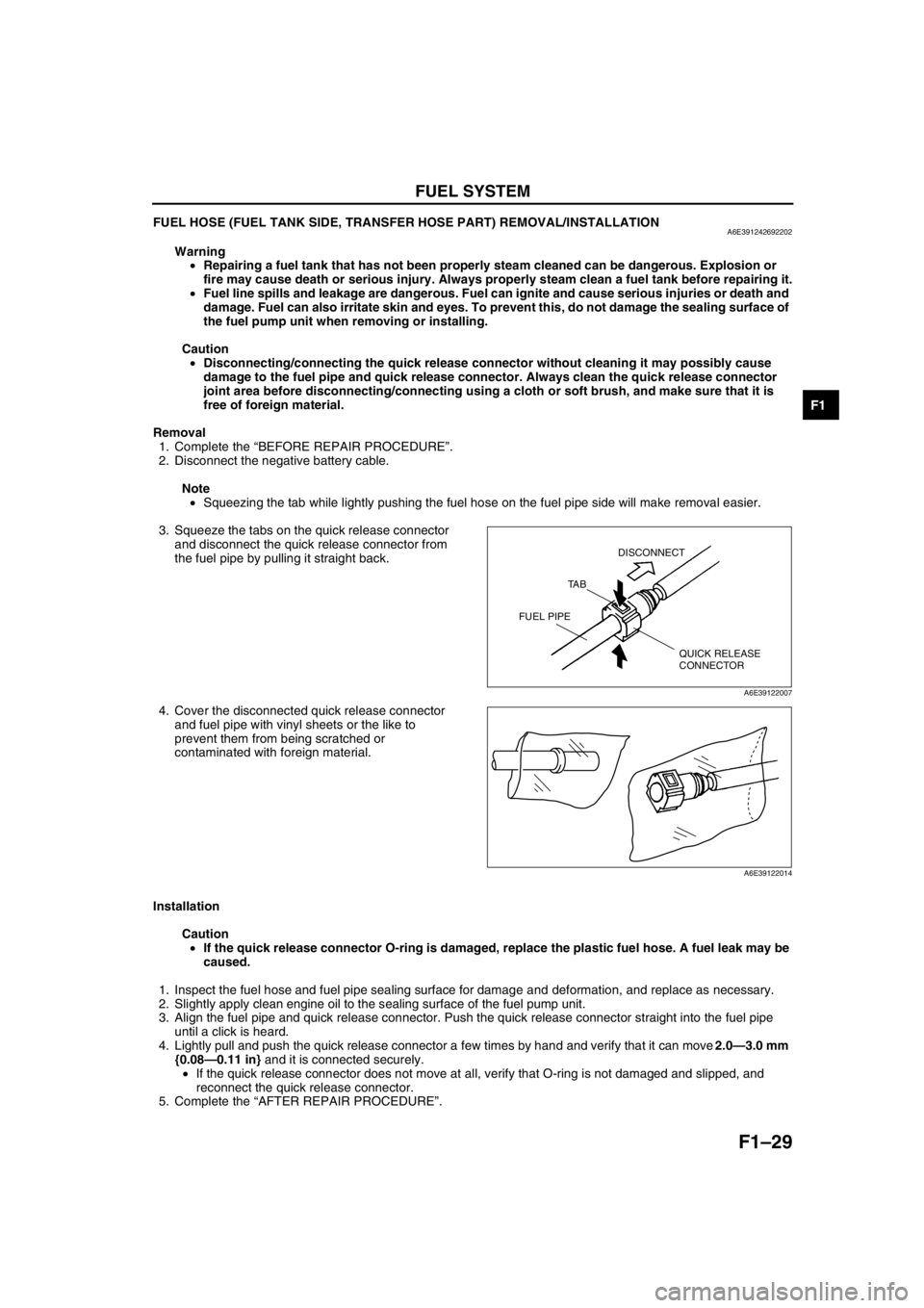
FUEL SYSTEM
F1–29
F1
FUEL HOSE (FUEL TANK SIDE, TRANSFER HOSE PART) REMOVAL/INSTALLATIONA6E391242692202
Warning
•Repairing a fuel tank that has not been properly steam cleaned can be dangerous. Explosion or
fire may cause death or serious injury. Always properly steam clean a fuel tank before repairing it.
•Fuel line spills and leakage are dangerous. Fuel can ignite and cause serious injuries or death and
damage. Fuel can also irritate skin and eyes. To prevent this, do not damage the sealing surface of
the fuel pump unit when removing or installing.
Caution
•Disconnecting/connecting the quick release connector without cleaning it may possibly cause
damage to the fuel pipe and quick release connector. Always clean the quick release connector
joint area before disconnecting/connecting using a cloth or soft brush, and make sure that it is
free of foreign material.
Removal
1. Complete the “BEFORE REPAIR PROCEDURE”.
2. Disconnect the negative battery cable.
Note
•Squeezing the tab while lightly pushing the fuel hose on the fuel pipe side will make removal easier.
3. Squeeze the tabs on the quick release connector
and disconnect the quick release connector from
the fuel pipe by pulling it straight back.
4. Cover the disconnected quick release connector
and fuel pipe with vinyl sheets or the like to
prevent them from being scratched or
contaminated with foreign material.
Installation
Caution
•If the quick release connector O-ring is damaged, replace the plastic fuel hose. A fuel leak may be
caused.
1. Inspect the fuel hose and fuel pipe sealing surface for damage and deformation, and replace as necessary.
2. Slightly apply clean engine oil to the sealing surface of the fuel pump unit.
3. Align the fuel pipe and quick release connector. Push the quick release connector straight into the fuel pipe
until a click is heard.
4. Lightly pull and push the quick release connector a few times by hand and verify that it can move 2.0—3.0 mm
{0.08—0.11 in} and it is connected securely.
•If the quick release connector does not move at all, verify that O-ring is not damaged and slipped, and
reconnect the quick release connector.
5. Complete the “AFTER REPAIR PROCEDURE”.
End Of Sie
QUICK RELEASE
CONNECTOR TA BDISCONNECT
FUEL PIPE
A6E39122007
A6E39122014
Page 124 of 909

F1–36
CONTROL SYSTEM
*1: Calculated value; differs from terminal voltage
*2: Refrigerant pressure switch (middle) turns on when the refrigerant pressure is 1.69—1.84 MPa {17.3—18.7
kgf/cm2, 247—265 psi}
*3: Refrigerant pressure switch (middle) turns off when the refrigerant pressure is 1.26—1.49 MPa {12.9—15.1
kgf/cm2, 184—214 psi}
*4: L3 and L8, LF (Intensely hot area) engine models
*5: Immobilizer system equipped model
*6: Immobilizer system not equipped
*7: L3 engine model only
*8: MTX model only
•Following PIDs are for the ATX models. If inspects for following PIDs, see K2–180 PID/DATA MONITOR
INSPECTION.
PIDs for the ATX models
—GEAR, LINEDES, LPS, OP_SW_B, SSA/SS1, SSB/SS2, SSC/SS3, TCS, TFT, TFTV, THOP, TR,
TR_SENS, TSS
RO2FT1 (Rear oxygen
sensor fuel trim)—Idle (after warm up): approx. –
0.03—0.03Perform applicable DTC
troubleshooting.—
RPM (Engine speed) rpm
LF Unleaded fuel (RON 90 or
above) model
No load: 600—700 rpm
E/L operating: 650—750 rpm
P/S operating: 650—750 rpm
A/C ON: 700—800 rpm
L3 4WD ATX model
No load: 650—750 rpm
E/L operating: 650—750 rpm
P/S operating: 650—750 rpm
A/C ON: 650—750 rpm*
2, 700—
800 rpm*3
Inspect CKP sensor. 2D, 2G
SEGRP (EGR valve
(stepping motor)
position)StepIgnition switch ON: 0 step
Idle: 0 step
Cranking: 0—60 stepsInspect following PIDs: MAF, TP,
ECT, RPM, VSS.
Inspect EGR valve.4E, 4H,
4K, 4N
SHRTFT1 (Short term
fuel trim)%Idle (after warm up): approx.–30—
25%Perform applicable DTC
troubleshooting.
(See F1–54 DTC TABLE)—
SPARKADV (Ignition
timing)°Ignition switch ON: BTDC 0°
Idle: BTDC approx. 10°Inspect following PIDs: MAF, TP,
ECT, RPM, INGEAR, TR, PSP,
ACSW, VPWR.
Inspect ignition timing.2J, 2M
TEST (Test mode) ON/OFF———
TP (TP)%CTP: 13—23%
WOT: 86—96%
Inspect TP sensor. 2A
VCTP: 0.65—1.15 V
WOT: 4.3—4.8 V
TPCT
(TP sensor voltage at
CTP )V0.65—1.15 V Inspect TP sensor. 2A
VPWR (Battery positive
voltage)V Ignition switch ON: B+Inspect main relay.
Inspect battery.2Y, 2Z
VSS (Vehicle speed) kph, mphVehicle speed 20 kph {12 mph}:
20 kph {12 mph}
Vehicle speed 40 kph {25 mph}:
20 kph {12 mph}Perform applicable DTC
troubleshooting.
(See F1–54 DTC TABLE)—
VT DUTY1*
7% Idle: 0%Inspect following PIDs: TP, ECT,
RPM.
Inspect OCV.2I, 2L Monitor item
(Definition)Unit/
ConditionCondition/Specification
(Reference)ActionPCM
terminal
Page 128 of 909
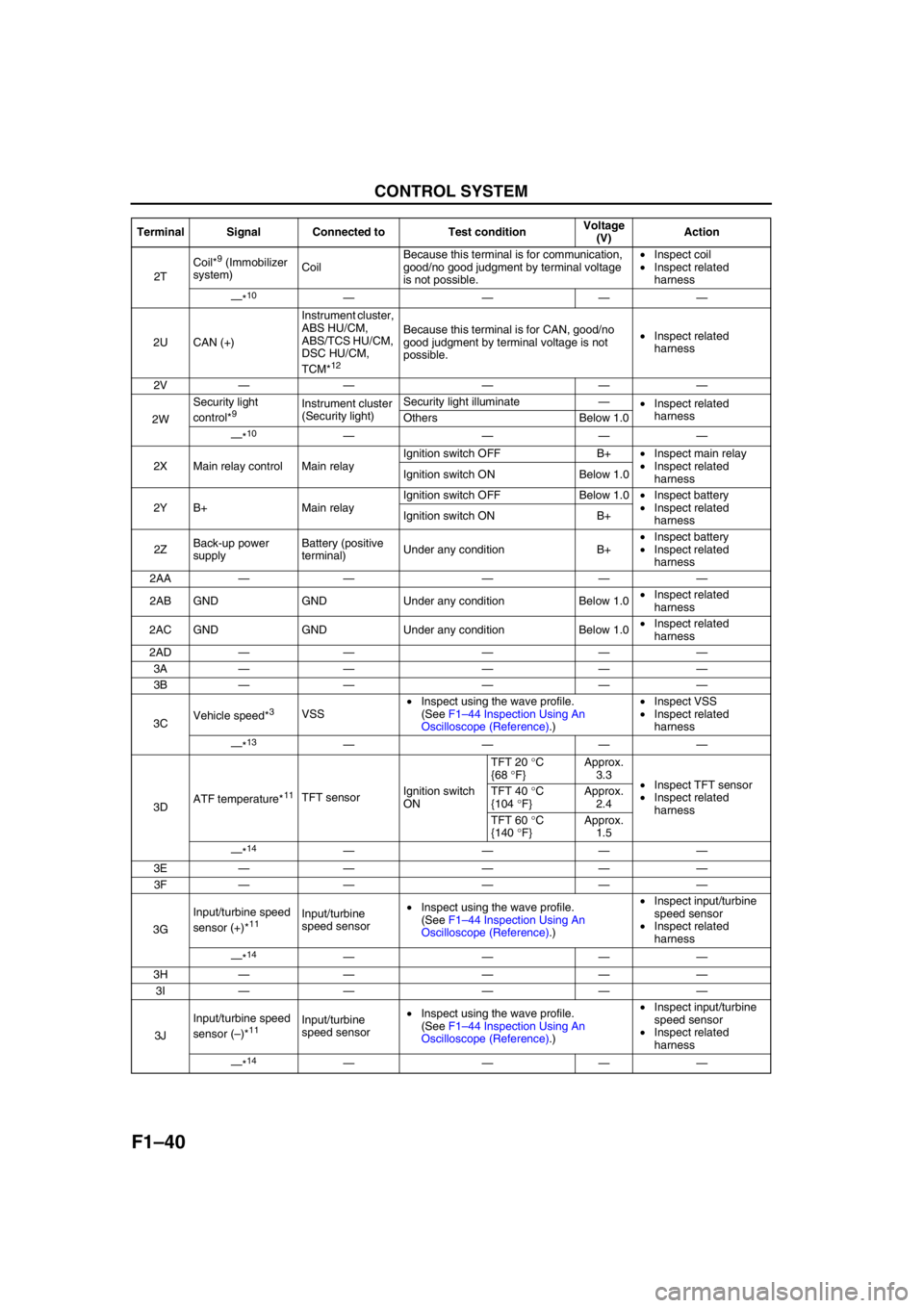
F1–40
CONTROL SYSTEM
2TCoil*
9 (Immobilizer
system)CoilBecause this terminal is for communication,
good/no good judgment by terminal voltage
is not possible.•Inspect coil
•Inspect related
harness
—*
10————
2U CAN (+)Instrument cluster,
ABS HU/CM,
ABS/TCS HU/CM,
DSC HU/CM,
TCM*
12
Because this terminal is for CAN, good/no
good judgment by terminal voltage is not
possible.•Inspect related
harness
2V—— — ——
2WSecurity light
control*
9Instrument cluster
(Security light)Security light illuminate—
•Inspect related
harness
Others Below 1.0
—*
10————
2X Main relay control Main relayIgnition switch OFF B+•Inspect main relay
•Inspect related
harness Ignition switch ON Below 1.0
2Y B+ Main relayIgnition switch OFF Below 1.0•Inspect battery
•Inspect related
harness Ignition switch ON B+
2ZBack-up power
supplyBattery (positive
terminal)Under any condition B+•Inspect battery
•Inspect related
harness
2AA—— — ——
2AB GND GND Under any condition Below 1.0•Inspect related
harness
2AC GND GND Under any condition Below 1.0•Inspect related
harness
2AD—— — ——
3A—— — ——
3B—— — ——
3CVehicle speed*
3VSS•Inspect using the wave profile.
(See F1–44 Inspection Using An
Oscilloscope (Reference).)•Inspect VSS
•Inspect related
harness
—*
13————
3DATF temperature*
11TFT sensorIgnition switch
ONTFT 20 °C
{68 °F}Approx.
3.3
•Inspect TFT sensor
•Inspect related
harness TFT 40 °C
{104 °F}Approx.
2.4
TFT 60 °C
{140 °F}Approx.
1.5
—*
14————
3E—— — ——
3F—— — ——
3GInput/turbine speed
sensor (+)*
11Input/turbine
speed sensor•Inspect using the wave profile.
(See F1–44 Inspection Using An
Oscilloscope (Reference).)•Inspect input/turbine
speed sensor
•Inspect related
harness
—*
14————
3H—— — ——
3I—— — ——
3JInput/turbine speed
sensor (–)*
11Input/turbine
speed sensor•Inspect using the wave profile.
(See F1–44 Inspection Using An
Oscilloscope (Reference).)•Inspect input/turbine
speed sensor
•Inspect related
harness
—*
14———— Terminal Signal Connected to Test conditionVoltage
(V)Action
Page 131 of 909

CONTROL SYSTEM
F1–43
F1
*1: Calculated value; differs from terminal voltage
*2: MTX models
*3: ATX models
*4: LF engine models
*5: L3 engine models
4QFuel pump control*
9Fuel pump relayIgnition switch ON B+•Inspect fuel pump
relay
•Inspect related
harness Cranking Below 1.0
Idle Below 1.0
—*
10————
4RVIC control*
5VIC control
solenoid valveEngine speed: above 4,500 rpm B+•Inspect VIC solenoid
valve
•Inspect related
harness Engine speed: below 4,500 rpm Below 1.0
—*
7————
4S—— — ——
4TVariable tumble
controlVariable tumble
control solenoid
valveECT above 63 °C { 145 °F} while
idling.B+•Inspect variable
tumble control
solenoid valve
•Inspect related
harness ECT below 63 °C {145 °F} and
engine speed below 3,750 rpmBelow 1.0
4U Purge controlPurge solenoid
valve•Inspect using the wave profile.
(See F1–44 Inspection Using An
Oscilloscope (Reference).)•Inspect purge
solenoid valve
•Inspect related
harness
4VB+*
3Main relayIgnition switch OFF Below 1.0•Inspect battery
•Inspect related
harness Ignition switch ON B+
—— — ——
4W Fuel injection (#2) Fuel injector No.2•Inspect using the wave profile.
(See F1–44 Inspection Using An
Oscilloscope (Reference).)•Inspect fuel injector
No.2
•Inspect related
harness
4X GND GND Under any condition Below 1.0•Inspect related
harness
4YShift solenoid C
control*
11Shift solenoid C•Inspect using the wave profile.
(See F1–44 Inspection Using An
Oscilloscope (Reference).)•Inspect shift solenoid
C
•Inspect related
harness
—*
14————
4Z Fuel injection (#1) Fuel injector No.1•Inspect using the wave profile.
(See F1–44 Inspection Using An
Oscilloscope (Reference).)•Inspect fuel injector
No.1
•Inspect related
harness
4AA Fuel injection (#4) Fuel injector No.4•Inspect using the wave profile.
(See F1–44 Inspection Using An
Oscilloscope (Reference).)•Inspect fuel injector
No.4
•Inspect related
harness
4ABShift solenoid A
control*
11Shift solenoid A•Inspect using the wave profile.
(See F1–44 Inspection Using An
Oscilloscope (Reference).)•Inspect shift solenoid
A
•Inspect related
harness
—*
14————
4ACShift solenoid B
control*
11Shift solenoid B•Inspect using the wave profile.
(See F1–44 Inspection Using An
Oscilloscope (Reference).)•Inspect shift solenoid
B
•Inspect related
harness
—*
14————
4AD Fuel injection (#3) Fuel injector No.3•Inspect using the wave profile.
(See F1–44 Inspection Using An
Oscilloscope (Reference).)•Inspect fuel injector
No.3
•Inspect related
harness Terminal Signal Connected to Test conditionVoltage
(V)Action
Page 139 of 909

ON-BOARD DIAGNOSTIC
F1–51
F1
P0112 IAT circuit low input ON 1 CCM×
P0113 IAT circuit high input ON 1 CCM×
P0117 ECT circuit low input ON 1 CCM×
P0118 ECT circuit high input ON 1 CCM×
P0121 TP stuck closed ON 2 CCM×
P0122 TP circuit low input ON 1 CCM×
P0123 TP circuit high input ON 1 CCM×
P0125 Excessive time to enter closed loop fuel control ON 2 CCM×
P0131 Front HO2S no inversion (stuck low) ON 2 CCM×
P0132 Front HO2S no inversion (stuck high) ON 2 CCM×
P0133 Front HO2S circuit malfunction ON 2O
2 sensor
×
P0134 Front HO2S circuit no activity detected ON 2 CCM×
P0138 Rear HO2S circuit high input ON 2 CCM×
P0140 Rear HO2S circuit no activity detected ON 2 CCM×
P0171 Fuel trim system too lean ON 2 Fuel×
P0172 Fuel trim system too rich ON 2 Fuel×
P0300 Random misfire detected Flash / ON 1 or 2 Misfire×
P0301 Cylinder No.1 misfire detected Flash / ON 1 or 2 Misfire×
P0302 Cylinder No.2 misfire detected Flash / ON 1 or 2 Misfire×
P0303 Cylinder No.3 misfire detected Flash / ON 1 or 2 Misfire×
P0304 Cylinder No.4 misfire detected Flash / ON 1 or 2 Misfire×
P0327 Knock sensor circuit low input ON 1 CCM×
P0328 Knock sensor circuit high input ON 1 CCM×
P0335 CKP sensor circuit malfunction ON 1 CCM×
P0340 CMP sensor circuit malfunction ON 1 CCM×
P0403 EGR valve motor coils open or short ON 2 CCM×
P0420 Catalyst system efficiency below threshold ON 2 Catalyst×
P0443Evaporative emission control system purge control
valve circuit malfunctionON 2 CCM×
P0480 Fan relay control circuit malfunction OFF 2 Other×
P0500 Vehicle speed sensor (VSS) circuit malfunction ON 2 CCM×
P0505 Idle control system malfunction OFF—Other—
P0506 Idle control system RPM lower than expected ON 2 CCM×
P0507 Idle control system RPM higher than expected ON 2 CCM×
P0511 Idle control system circuit malfunction ON 1 CCM×
P0550 PSP switch circuit malfunction ON 2 CCM×
P0602 PCM programming error ON 1 CCM×
P0610 Control module vehicle options error ON 1 CCM×
P0661 VIS control circuit low input OFF 2 Other×
P0662 VIS control circuit high input OFF 2 Other×
P0703 Brake switch input malfunction ON 2 CCM×
P0704 Clutch switch input malfunction ON 2 CCM×
P0850 Neutral switch input malfunction ON 2 CCM×
P1410 Variable air duct valve circuit malfunction OFF 2 Other×
P1562 PCM +BB voltage low ON 1 CCM×
P2006 Variable tumble control shutter valve stuck closed ON 2 CCM×
P2009 Variable tumble control solenoid circuit low input ON 2 CCM×
P2010 Variable tumble control solenoid circuit high input ON 2 CCM×
P2228 BARO sensor circuit low input ON 1 CCM×
P2229 BARO sensor circuit high input ON 1 CCM×
P2502 Generator output voltage signal no electricity OFF 1 Other—
P2503 Battery overcharge OFF 1 Other—
P2504 Generator terminal B circuit open OFF 1 Other—
U0073 CAN bus off OFF 1 Other— DTC No. Condition MIL DC Monitor itemMemory
function
Page 140 of 909
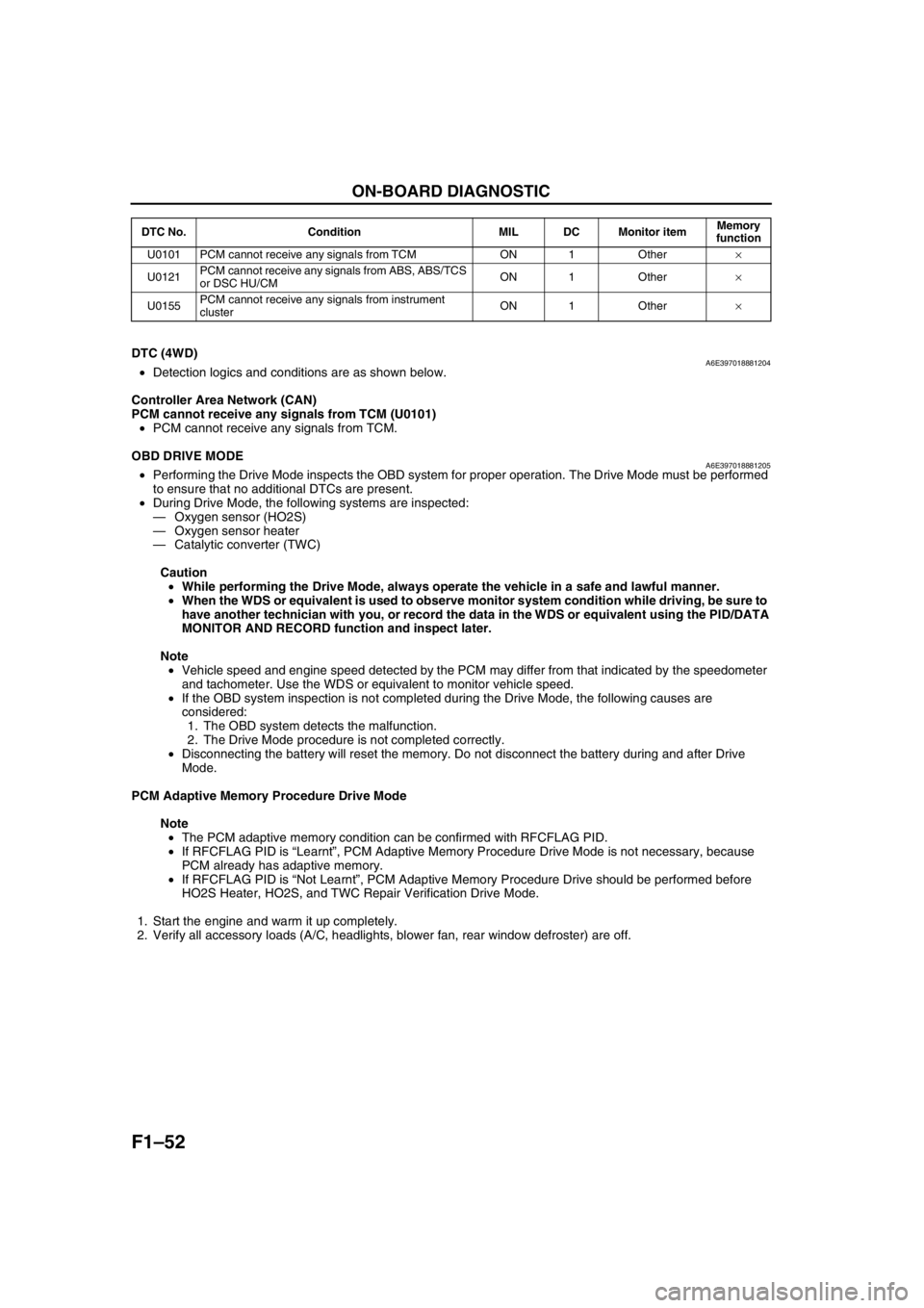
F1–52
ON-BOARD DIAGNOSTIC
End Of Sie
DTC (4WD)A6E397018881204•Detection logics and conditions are as shown below.
Controller Area Network (CAN)
PCM cannot receive any signals from TCM (U0101)
•PCM cannot receive any signals from TCM.
End Of Sie
OBD DRIVE MODEA6E397018881205•Performing the Drive Mode inspects the OBD system for proper operation. The Drive Mode must be performed
to ensure that no additional DTCs are present.
•During Drive Mode, the following systems are inspected:
—Oxygen sensor (HO2S)
—Oxygen sensor heater
—Catalytic converter (TWC)
Caution
•While performing the Drive Mode, always operate the vehicle in a safe and lawful manner.
•When the WDS or equivalent is used to observe monitor system condition while driving, be sure to
have another technician with you, or record the data in the WDS or equivalent using the PID/DATA
MONITOR AND RECORD function and inspect later.
Note
•Vehicle speed and engine speed detected by the PCM may differ from that indicated by the speedometer
and tachometer. Use the WDS or equivalent to monitor vehicle speed.
•If the OBD system inspection is not completed during the Drive Mode, the following causes are
considered:
1. The OBD system detects the malfunction.
2. The Drive Mode procedure is not completed correctly.
•Disconnecting the battery will reset the memory. Do not disconnect the battery during and after Drive
Mode.
PCM Adaptive Memory Procedure Drive Mode
Note
•The PCM adaptive memory condition can be confirmed with RFCFLAG PID.
•If RFCFLAG PID is “Learnt”, PCM Adaptive Memory Procedure Drive Mode is not necessary, because
PCM already has adaptive memory.
•If RFCFLAG PID is “Not Learnt”, PCM Adaptive Memory Procedure Drive should be performed before
HO2S Heater, HO2S, and TWC Repair Verification Drive Mode.
1. Start the engine and warm it up completely.
2. Verify all accessory loads (A/C, headlights, blower fan, rear window defroster) are off.
U0101 PCM cannot receive any signals from TCM ON 1 Other×
U0121PCM cannot receive any signals from ABS, ABS/TCS
or DSC HU/CMON 1 Other×
U0155PCM cannot receive any signals from instrument
clusterON 1 Other× DTC No. Condition MIL DC Monitor itemMemory
function
Page 143 of 909

ON-BOARD DIAGNOSTIC
F1–55
F1
P0133 Front HO2S circuit malfunction ON 2O2 sensor
×—
P0134Front HO2S circuit no activity
detectedON 2 CCM×—
P0138 Rear HO2S circuit high input ON 2 CCM×—
P0140Rear HO2S circuit no activity
detectedON 2 CCM×—
P0171 Fuel trim system too lean ON 2 Fuel×—
P0172 Fuel trim system too rich ON 2 Fuel×—
P0300 Random misfire detected Flash / ON 1 or 2 Misfire×—
P0301 Cylinder No.1 misfire detected Flash / ON 1 or 2 Misfire×—
P0302 Cylinder No.2 misfire detected Flash / ON 1 or 2 Misfire×—
P0303 Cylinder No.3 misfire detected Flash / ON 1 or 2 Misfire×—
P0304 Cylinder No.4 misfire detected Flash / ON 1 or 2 Misfire×—
P0327 Knock sensor circuit low input ON 1 CCM×—
P0328 Knock sensor circuit high input ON 1 CCM×—
P0335 CKP sensor circuit malfunction ON 1 CCM×—
P0340 CMP sensor circuit malfunction ON 1 CCM×—
P0403EGR valve motor coils open or
shortON 2 CCM×—
P0420Catalyst system efficiency
below thresholdON 2 Catalyst×—
P0443Evaporative emission control
system purge control valve
circuit malfunctionON 2 CCM×—
P0480Fan relay control circuit
malfunctionOFF 2 Other×—
P0500Vehicle speed sensor (VSS)
circuit malfunction (MTX)ON 2 CCM×—
P0505 Idle control system malfunction OFF—Other——
P0506Idle control system RPM lower
than expectedON 2 CCM×—
P0507Idle control system RPM higher
than expectedON 2 CCM×—
P0511Idle control system circuit
malfunctionON 1 CCM×—
P0550 PSP switch circuit malfunction ON 2 CCM×—
P0602 PCM programming error ON 1 CCM×—
P0610Control module vehicle options
errorON 1 CCM×—
P0661 VIS control circuit low input OFF 2 Other×—
P0662 VIS control circuit high input OFF 2 Other×—
P0703 Brake switch input malfunction ON 2 CCM×—
P0704 Clutch switch input malfunction ON 2 CCM×—
P0850 Neutral switch input malfunction ON 2 CCM×—
P1410Variable air duct valve circuit
malfunctionOFF 2 Other×—
P1562 PCM +BB voltage low ON 1 CCM×—
P2006Variable tumble control system
shutter valve stuck closedON 2 CCM×—
P2009Variable tumble control solenoid
valve circuit low inputON 2 CCM×—
P2010Variable tumble control solenoid
valve circuit high inputON 2 CCM×—
P2228 BARO sensor circuit low input ON 1 CCM×—
P2229 BARO sensor circuit high input ON 1 CCM×—
P2502Generator output voltage signal
no electricityOFF 1 Other——
P2503 Battery overcharge OFF 1 Other—— DTC No. Condition MIL DC Monitor itemMemory
functionPage